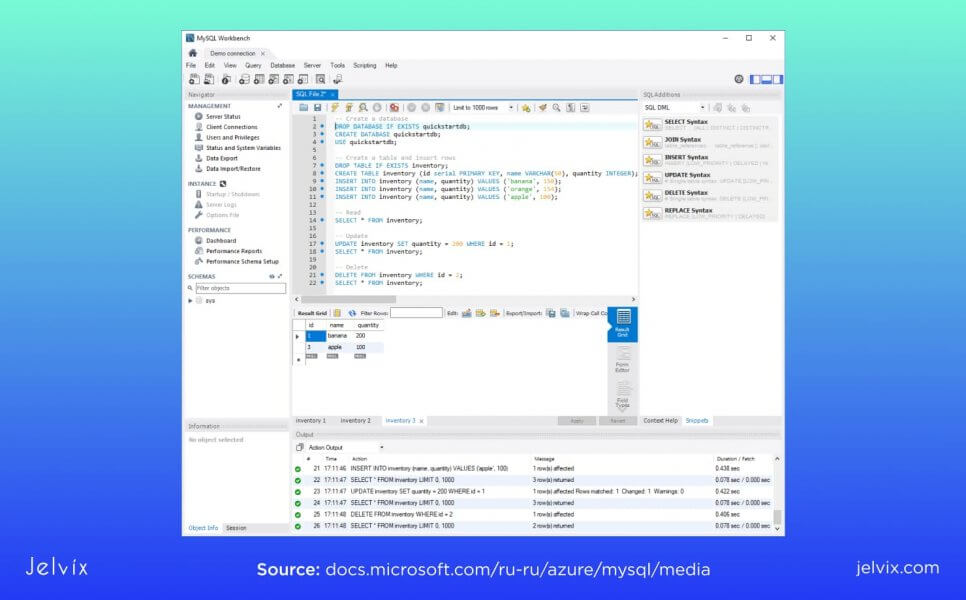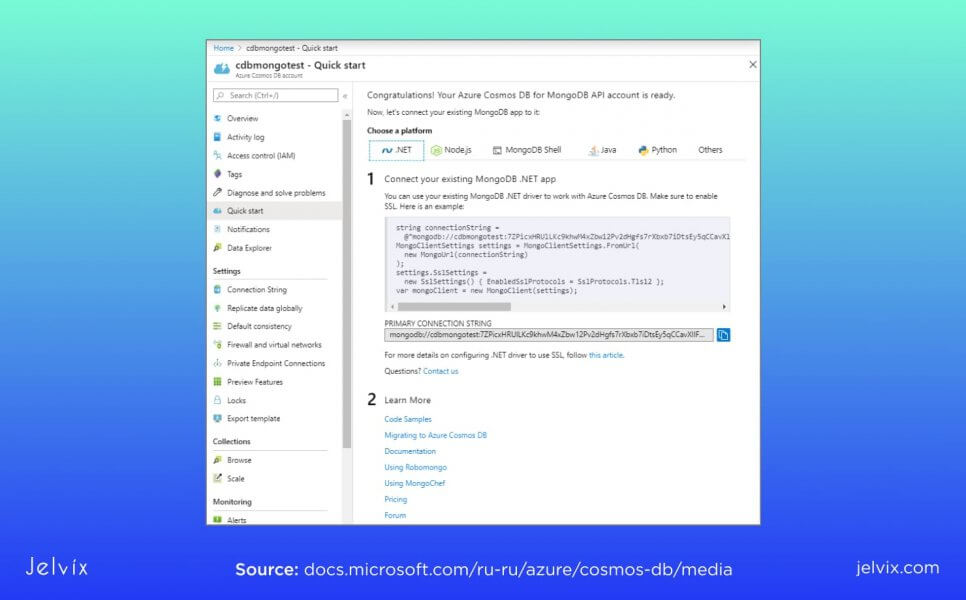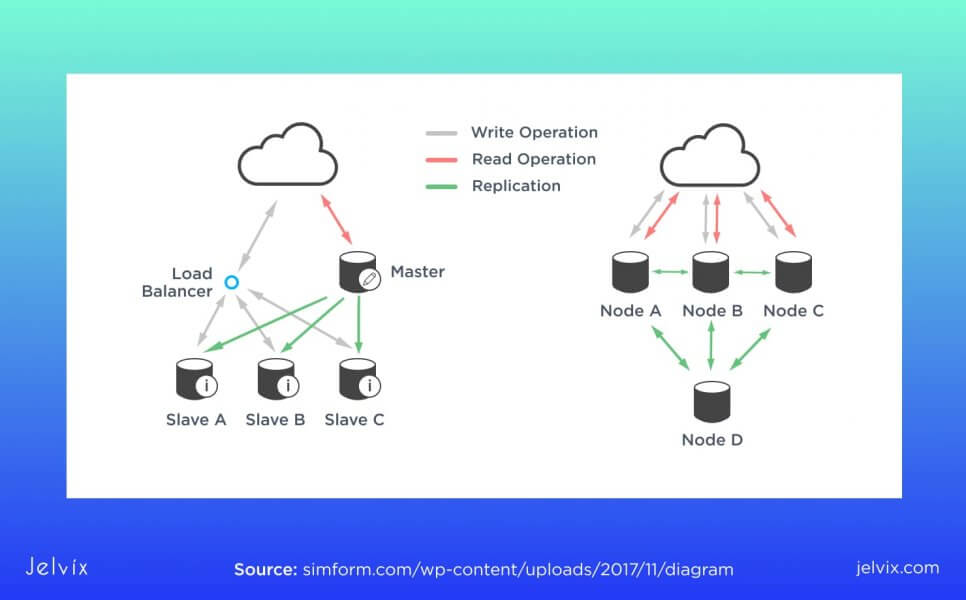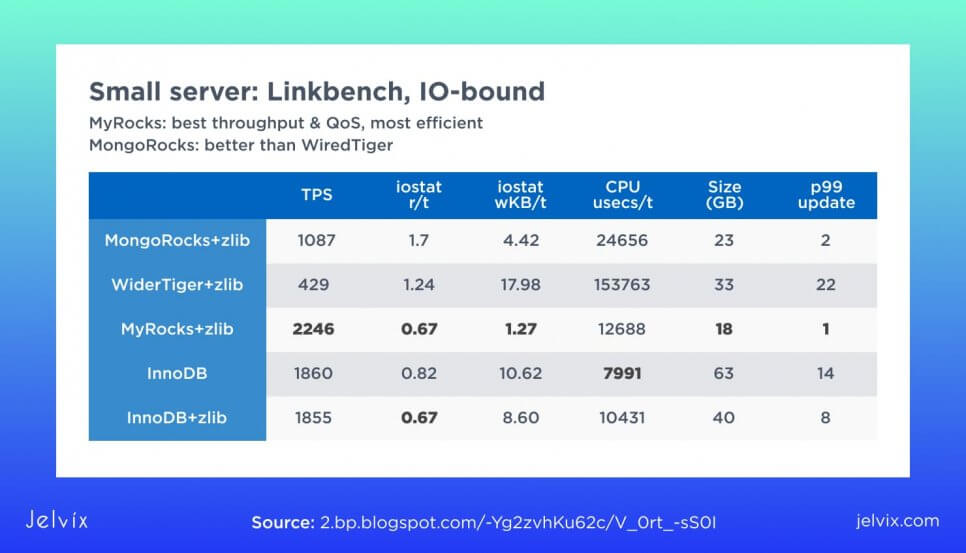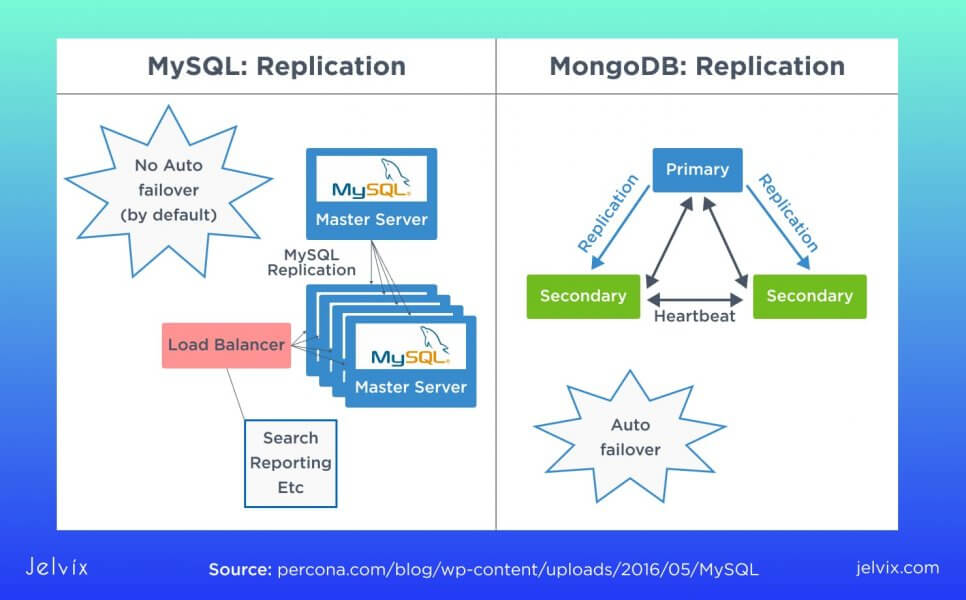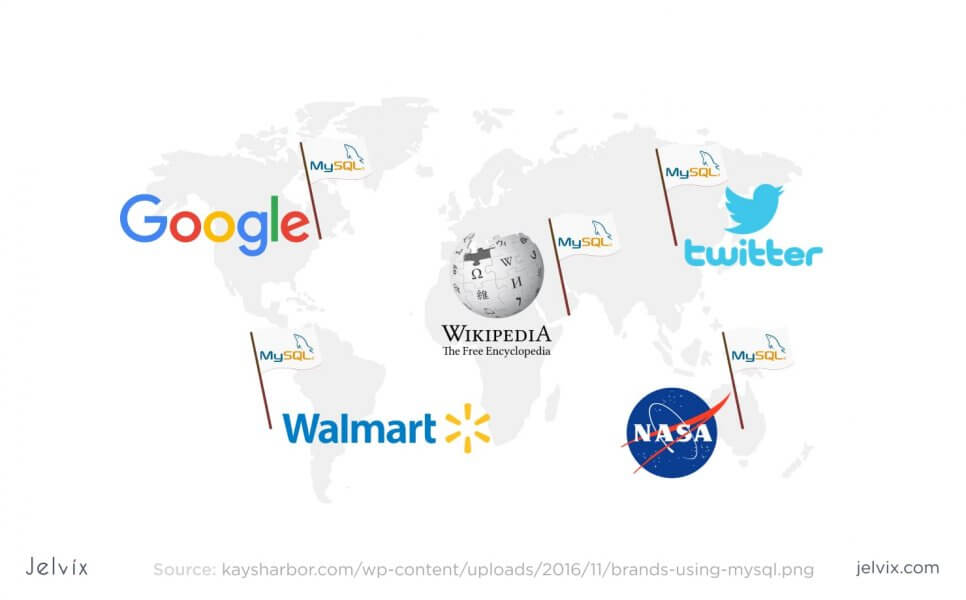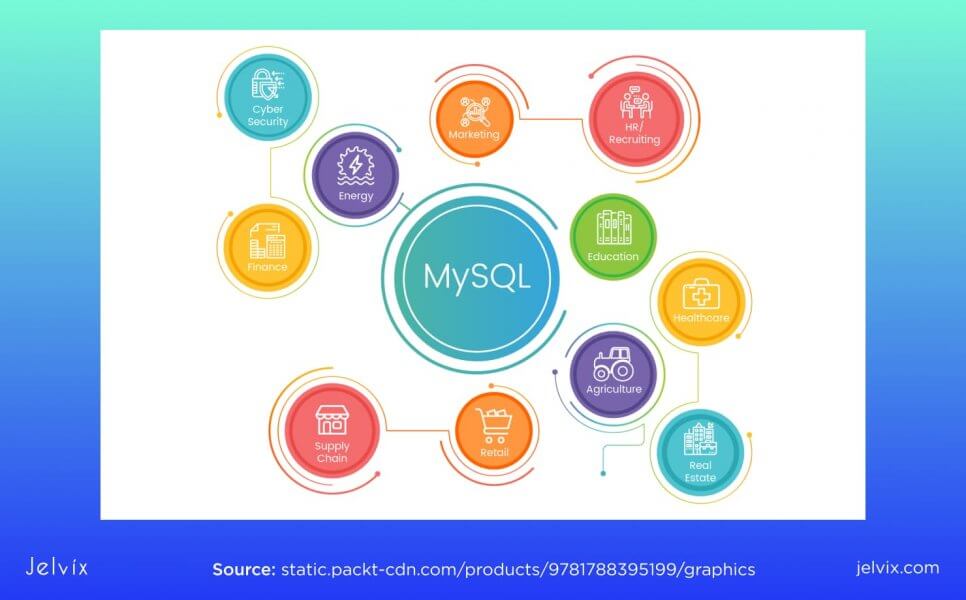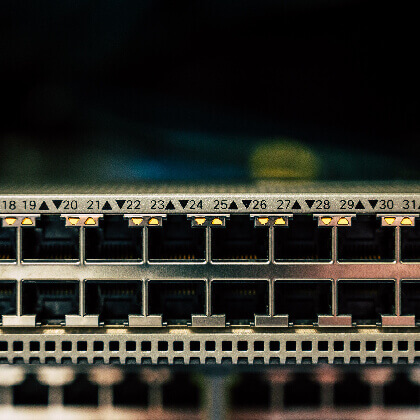Lately, the situation with database popularity and adoption has been showing some interesting trends. According to the ranking of DB Engines, open-source solutions are quickly gaining traction, while commercial software is lowering its reach. MongoDB vs MySQL competition has been an interesting example of this trend.
Another tendency that isn’t presented so drastically, but still exists, is a switch from relational databases to non-relational ones. The choice of a database often starts from analyzing the most popular tools – MySQL for relational solutions, and MongoDB for non-relational databases.
A brief description of MySQL
MySQL is one of the most popular databases, and it has been leading database rankings for dozens of years. Facebook, Uber, Paypal, Youtube, Amazon, Adobe, and LinkedIn use MySQL for their website data layers. About 9 of 10 sites on the Internet are powered by MySQL.
The main advantages of adopting MySQL is its rich and tried-and-proven ecosystem. There are plenty of educational resources, established tech stacks, and guides. Since it’s an SQL-based relational database, developers can easily integrate other SQL solutions (PostgreSQL, for instance), or even migrate the project altogether.
MySQL is known for its fine-tuned support of complex queries, analytical operations, and transactions. It also has the reputation of being one of the safest databases on the market.
A brief description of MongoDB
MongoDB is a non-relational database that doesn’t use SQL or tables the way relational solutions do – like MySQL, actually. Instead, MongoDB creates documents that store connected information and use a custom language – Mongo Query Language – for communication.
Each document can have an independent structure and govern different types of data. Developers don’t have to add columns or connect tables, and this obviously contributes to higher development speed. The learning curve is lower since there’s no need to learn SQL.
The main advantage of adopting MongoDB is a flexible data model. You don’t need to stick to one schema for the entire development process – each document governs its own structure. Scaling, editing the database structure, and adding new documents is a lot easier.
MySQL vs MongoDB: comparison
MySQL and MongoDB clearly illustrate differences in development approaches between SQL and non-SQL databases. This is why both have respective advantages and disadvantages and fit different projects.
Architectural approaches
MySQL is a relational database, so all data is stored in tables. Developers can clearly see the connections between entries, sort through duplicated, damaged, or irrelevant information. Since one particular table can be changed easily, there is no need to modify a single large document.
On the one hand, tables provide a higher level of organization, but on the other hand, require a lot of preparation. Some data can’t be represented in tables properly – especially if these are big text files, like open answers in user registration.
MySQL development characteristics:
- The relational structure requires a team to plan the database structure early on and requires a lot of organization;
- Data is easily used by different applications;
- MySQL easily handles long-lived projects – many sites, built with MySQL, work for 10-15 years;
- Long-term stability: since all the data is sorted, there are no duplication risks or irrelevant entries.
In MongoDB, developers don’t need to organize the data before entering it into a database. The database allows building software quickly because there’s space for constant change. Developers are not limited by formats, schemas, or relations between tables. As soon as you build a database for a single application, MongoDB will deliver high scalability and fast performance.
If you are building a database that will simultaneously interact with multiple applications, MongoDB doesn’t provide algorithms for controlling these interactions. This is why MongoDB is a top choice for simple, short-lived applications, where data organization is not the main priority.
MongoDB development characteristics:
- Use of documents instead of tables removes the need to sort through the data and predefine the database schema;
- Increased development speed;
- Easy scalability: you can change something anytime;
- No unnecessary customization: JSON-documents don’t require additional organization.
Language
MySQL is an SQL database that uses Structured Query Language to structure and describe data. MongoDB is a non-SQL database that uses a mix of general-purpose programming languages: it was written in JS, Go, C++, and Python.
SQL requires developers to define the schema of the database before uploading data. The information should be structured in a way that would make it convenient for table structure. For numeric data, it’s a perfect representation method. However, non-standard content formats are difficult to be converted into a classical relational model.
Advantages of using SQL for data organization
- SQL is used by many databases, not just by MySQL. Developers can use their experience of working with one tool for the whole range of solutions.
- SQL is highly organized: developers see the visual representation of data structure and relations between the storage;
- SQL handles complex operations well: if the table is organized well, the application will take less than a few seconds to perform even a complex request.
- SQL respects ACID: the rule saying the database should be atomic (all-or-nothing), consistent (always happen under the same conditions with certain guarantees), isolated (transactions should happen independently), and durable (the data isn’t lost or damaged).
Disadvantages
The main issue with the SQL language is its lack of simplicity and flexibility. Developers need to create a schema that will remain consistent for the entire database during the whole lifecycle of the application. Switching to a different schema is complicated and time-consuming, which requires developers to invest a lot of time and effort in planning and research.
Advantages of using a Non-SQL language
The main advantage of MongoDB over SQL databases, including MySQL, is the lack of predefined structure. Developers don’t have any need to optimize a schema, as the structure of the document can be changed at any time.
- Documents and applications see data in the same way as applications. Rows and columns are an SQL-specific way of data representation. MongoDB uses arrays and subdocuments – structures that are clear for applications.
- New document attributes can be added anytime. JSON documents can be modified independently from the centralized database structure. It won’t cause performance issues and bottlenecks, like in MySQL.
- Increased speed. The application only needs to access a single document to execute an operation. There’s no need to track all the relations to the data and analyze different tables. The increased speed is especially noticeable in small applications – with big documents, the effect is no longer apparent.
Disadvantages of NoSQL databases
NoSQL databases aren’t compatible with other solutions. Each NoSQL solution uses a unique approach to creating databases and organizing data. They are also not compatible with any SQL tools.
Also, they are less organized and not as secure. ACID principles aren’t present in MongoDB, so the system won’t alert you about duplication, which causes an issue that leads to messy JSON files.
Development specifics of MySQL versus MongoDB
The development process on MongoDB and MySQL differs not only in the fundamental principles but even in smaller aspects – like software terminology. Some categories are present in both tools, but others are entirely different. A MySQL table becomes a collection, and a column gets to be a field in MongoDB.
MySQL uses JOIN to build relations between tables, whereas MongoDB doesn’t offer the same option. Documents are integrated via identification or embedding. Let’s take a look at some examples, just to give you an idea.
Customization, search, and settings are generally more precise in MySQL. You can set up the level of isolation of a data transaction, edit its replications, configure logs, etc. In MongoDB, the options are much more limited. Documents are isolated by definition, but within a document, you can’t isolate the transactions themselves (unless you write some additional code). If your documents are big, you’ll have to update a lot of transactions simultaneously.
MongoDB vs MySQL performance
If we compare the MySQL vs MongoDB speed of executing basic features – like Insert, Update, and Select, MongoDB is 2-3 times faster than MySQL.
However, if we evaluate performance by assessing CPU consumption, MySQL is a clear winner. MongoDB can produce faster results if it has large computing power at its disposal. MySQL is slower by design, but it works better in limited conditions.
For small projects or real-time applications, where security is the main competitive advantage, MongoDB is likely a better bet. For large platforms that already consume a lot of CPU, adding more load with a demanding database doesn’t make any sense – so MySQL is a better option.
MySQL vs MongoDB scalability
SQL databases offer vertical scalability: developers can increase the load on the server to perform operations. Scalability required increasing CPU, SSD, and RAM of the server.
Non-SQL databases allow adding more servers rather than increasing a single one. Theoretically, this approach is a lot more efficient – one server, even the most powerful one, can’t perform as well as multiple servers.
MySQL sharding
To accommodate big databases and multiple transactions, developers prefer to divide a single server into partitions. Each partition can be deployed on a separate server – this allows MySQL to use horizontal scaling along with the vertical one.
To perform sharding in MySQL, teams use frameworks. Google uses Vittess to shard information for Youtube – it’s available as an open-source product. Facebook and Twitter use custom-sharding solutions to accommodate the needs of their large MySQL databases.
MongoDB sharding and horizontal scaling
MongoDB allows you to perform sharding with no additional frameworks. Developers can generate replica sets directly in the application and store different documents on different servers right away.
Comparing MySQL vs MongoDB replication, it’s clear that it is definitely MongoDB’s strong suit. Data replication doesn’t require migration to the framework, so it’s intuitive and fast.
Administration
Teams will have to deal with the administration and maintenance of a database during the entire application’s lifecycle. It’s responsible for backup creation, updates, and workload handling.
MySQL offers many ways to replicate a database, but all of them are slightly complex. The system doesn’t have a standard approach to database management. Let’s take a look at the most common approaches.
- Statement-based replication handles the entire statements;
- Row-based replication handles data updates, not the statements themselves.
- GTID-replication: the transactions are replicated with their IDs.
MySQL’s administration methods are difficult to learn and easy to confuse. Still, there are some advantages – having options provides more flexibility, and there are thousands of open-source tools.
MongoDB offers Ops Manager – a paid tool for administration and replication. The database offers a single simple way to replicate documents: you can shard each router and configure servers independently. There’s no need to break down a single server into partitions, therefore you can just work on different servers.
A downside of administration in MySQL is a lack of an active open-source community. Most options are limited to paid tools within the MongoDB ecosystem.
Everything you need to know about big data tools– functionality, use cases, drawbacks – is here.
Advantages and disadvantages of MySQL
So, let’s recap the advantages and disadvantages of MySQL vs MongoDB in checklists.
- Fast performance: as the project scales, handling big documents becomes uncomfortable. For langue platforms, MySQL is a better-performing solution.
- High stability: a predefined schema provides developers with a steady structure, systemizing their data, controlling its compatibility, and detecting duplication. The database is more predictable and highly reliable.
- Security: because SQL follows ACID principles, all transactions are thoroughly approved, monitored, and well-isolated. MySQL also offers a lot of additional settings for access management and isolation.
- High-level organization: developers clearly see the relations between data and can quickly detect errors;
- Reusability: you can use predefined schemas on different projects, minimizing the up-front preparation. The more experienced the team is in SQL development, the faster they will come up with an optimal schema.
- Portable procedures: developers can store MySQL procedures, and they will run on different applications and OSs. You can write a single operation and distribute it to multiple versions of the application.
Disadvantages
- Difficult database organization: a schema can’t be changed during the development process. It will require transferring data back-and-forth and updating all the relations.
- Time-consuming editing: developers need to make sure that the data in tables responds to multiple database standards. Issues like typos or incorrect relation setup can affect the performance of the entire table.
- Mandatory data organization: developers can’t simply add the information to the table without structuring it into a column-row format.
- Poor accommodation of unstructured data: all the data needs to fit into a table. For some types of information, such as numbers or emails, it will not be a problem. However, large entries (texts, open answers) might not fit the size or be difficult to connect.
Advantages and disadvantages of MongoDB
The approach taken by NoSQL MongoDB is often opposite from what MySQL offers. This is why their benefits and drawbacks are somewhat inverted – MongoDB has not inherited some of the positive SQL characteristics, but on the other hand, managed to resolve several important issues.
Advantages
- Flexibility: a JSON document can be edited independently anytime and doesn’t affect any other file. Unlike SQL, where due to relationships, changes can impact the entire structure, JSON documents are flexible.
- Support of unstructured data: developers don’t need to enter information into rows and columns. They use sub-documents and arrays, which are more intuitive and flexible.
- High readability: MongoDB doesn’t require developers to access different tables to collect related information. All the data can be accessible in a single document.
- Easy setup: developers don’t need to predefine schema and plan relations.
Disadvantages
- A lower level of organization: MongoDB’s documents tend to get messy over time if developers don’t prioritize the organization.
- Duplication: MongoDB doesn’t detect duplication automatically. However, developers can use additional tools to catch repeated content in the documents.
- High CPU consumption: MongoDB delivers a higher performance speed, but it happens at the expense of the CPU – we’ve seen the statistics on the graph.
- Larger size of a database: if developers don’t sort through documents, the size of the database might likely grow 2-3 times more than a respective MySQL data layer.
Companies using MySQL
MySQL has been around for 25 years – it’s no wonder that a lot of MySQL-supported software has emerged over the years, and a lot of it still has successful functionality. Obviously, it’s proof of MySQL’s tried-and-proven stability.
- Youtube
- Airbnb
- Netflix
- Spotify
- NASA
The database is used equally by commercial projects and governmental platforms. Sites of American government, CERN, research institutions are all powered by MYSQL.
Companies using MongoDB
MongoDB is a relatively young database, so its client base mostly consists of newly appeared platforms, apps, software-as-a-service, or companies who have decided to migrate to MongoDB from relational databases (like eBay).
- Adobe
- eBay
- Uber
- Paypal
- UPS
We’ll likely witness more cases of migration to MongoDB in the future. Teams that handle complex data, especially visual, social, and GPS, prefer to work with flexible JSON documents, rather than breaking files into columns and rows.
Use cases for MySQL
MySQL is a top choice for large platforms that prioritize security and stable performance. Businesses that prioritize long-term reliability, stability, and reputation over MongoDB’s simplicity, should consider MySQL. Here’s where we’d recommend using MySQL.
eCommerce applications
The data, handled by e-commerce platforms, is mostly numerical and easy to break into an SQL structure. High stability, security, and low-CPU consumption allow e-commerce platforms to run with no down-times and handle big workloads.
MySQL is usually used to store product catalogs, purchase histories, transaction data prices, discounts, etc. For analytics and synchronized data, developers sometimes integrate non-relational databases, like MongoDB.
LAMP Open-source stack
MySQL is used in a popular open-source tech stack that consists of Linux, Apache, MySQL, and PHP. Using LAMP has a lot of advantages: it’s free, well-developed, and has a rich ecosystem. LAMP is a common choice for dynamic web development, as well as multi-page web applications.
Governmental websites
MySQL is a database that powers NASA, US Navy, and United Nations web platforms. It’s also used in classified scientific research – MySQL stores CERN data, for instance. ACID compliance and a wide range of security customizations make MySQL a tried-and-proven choice for storing sensitive data.
Governmental organizations don’t regard the speed of development or scalability as their main priority. Instead, they focus on long-term sustainability and safety.
Use cases for MongoDB
MongoDB is a top choice for platforms that handle a lot of non-numeric data. A large amount of text, images, real-time analytics, and tracking are usually powered by the non-relational database. If you ask us, we prefer using MongoDB for content- and data-driven projects.
Asset management and item catalogs
The JSON document structure doesn’t limit developers to breaking down the product data into multiple tables. It’s comfortable to store the essential product data together with its metadata. Teams can create separate files for different categories. As the platform grows, developers can simply add new documents to accommodate more categories or analytics – there’s no need to impact the entire database.
Real-time analytics
Collecting data on a per-minute or even per-second basis requires a great deal of flexibility from a database. Predefined schema of SQL databases can’t accommodate large volumes of constantly changing data unless you use custom tools. MongoDB, on the other hand, due to its flexible structure, deals especially well with GPS and unstructured data.
Content management
A lot of companies switch their CMS from MySQL to MongoDB because of its higher scalability or flexibility – Forbes, for instance, has just done so. SQL solutions, like MySQL, limit teams to schemas that can’t be adapted to user needs, hold many different assets together, or grow quickly. Creating new relations between a database in SQL tools takes a lot of time, and these connections aren’t always accurate.
Can MongoDB replace MySQL?
As for now, MongoDB doesn’t come close to being a MySQL replacement. There are plenty of use cases where MySQL fits the project requirements a lot better than a non-SQL solution. SQL is still a standard for data storage and processing.
NoSQL databases allow doing things faster and growing easier, but they don’t offer the same level of organization or stability. For now, the two tools will co-exist, solving different technical issues, and catering to respective use cases.
Conclusions
MySQL is a tried-and-proven system with a rich ecosystem and high-security standards. Increased reliability, however, comes at the expense of long preparation and up-front decisions. MongoDB is easier in terms of development and scaling, and its JSON structure is more flexible than relative tables. It’s less secure and organized, which makes it not the best choice for storing confidential information.
The choice depends entirely on your project’s priority and available skills. Whichever option you choose, Jevlix developers are ready to build a database for you. We have expert teams both for MongoDB and MySQL – so you can choose either, or even combine both.
Need a qualified team of developers?
Access the talent pool to scale your team capacity.


